In China, local varieties of rice are dwindling, plummeting from more than 46,000 varieties in the 1940s to more than 1,000 in the 1990s.
When a farmer in Yunnan decides to stop growing rice in the mountains, what does it mean?
A documentary produced by Greenpeace East Asia and aired at the first “Duck Knows First Cultural Festival”, asks this question.
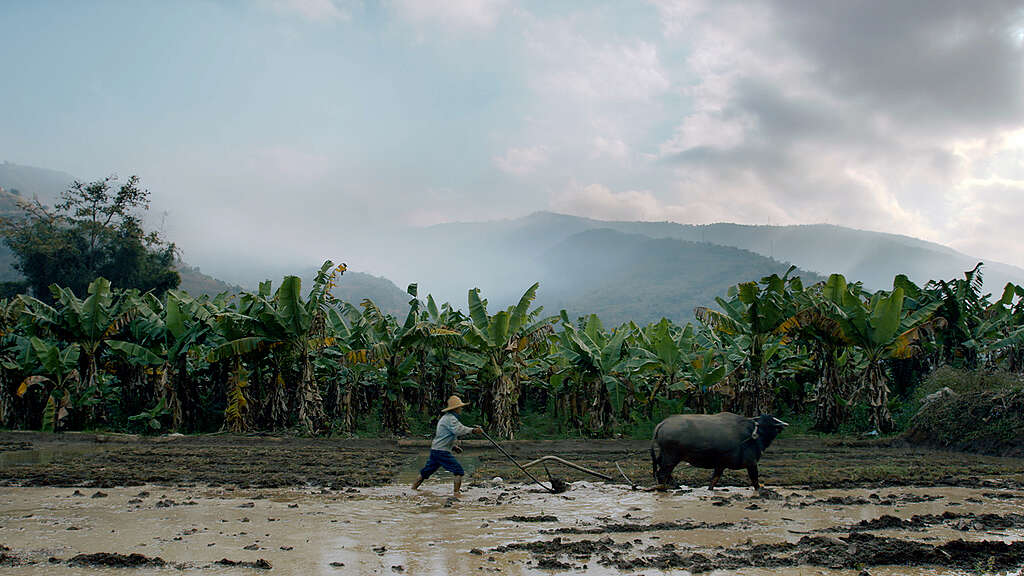
A rice farmer using a plow driven by an ox. A still taken from “Unhusk”.
Five farmers from Yunnan province took part in Greenpeace’s “Road to Rice” program back in 2004, doing photography that documented traditional rice farming methods of these Indigenous Peoples, who are ethnic minority groups in China.
“Rice is our life,” Ah-Simei (a nickname that indicates she is the fourth daughter in her family) from Pan Tian Ke village was recorded saying in a video back then. Not only do people eat the rice, she explained, but it’s fed to cows and horses. They feed rice bran to the bigs. They feed the cracked grains that are screened out of the crop to the baby chickens. When they compost animal manure, they add unused rice to it, and complete a new cycle.
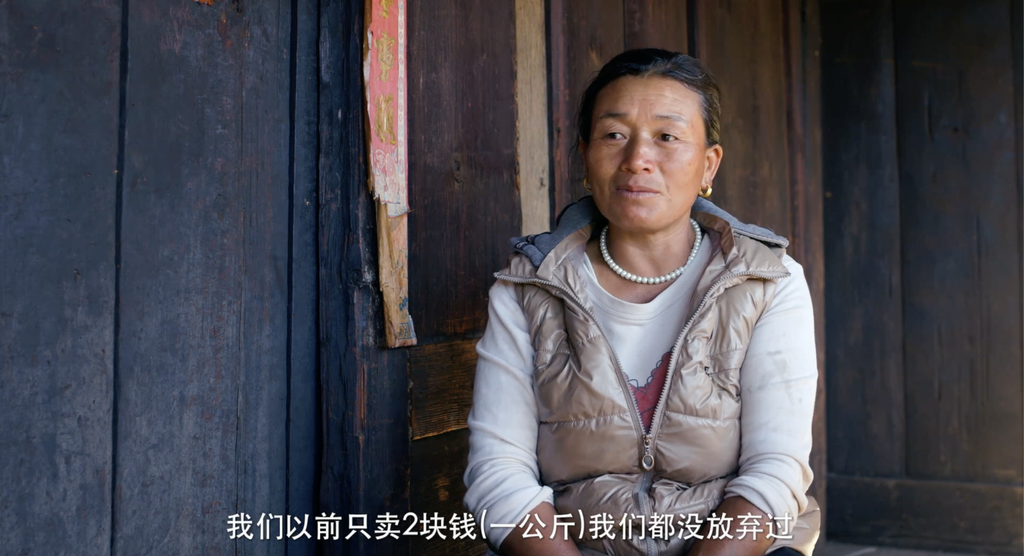
Ah-Simei. A still taken from “Unhusk”.
But after returning ten years later, the documentary team found that only one among the five was still growing rice.
Returning after 10 years, the director asked Ah-Simei, the only one still growing rice ten years later, “How much do you think a catty (two kilograms) of your rice should cost?”
She replied: “¥100 RMB a catty,” adding that she would only plant if it made at least ¥10 RMB per catty. In reality, at that time, rice could only be sold for about ¥2 to ¥3 RMB per catty.
It’s an old story. Children have to go to school. The elderly retire. Young people build houses, get married. And farmers bow to the market. They need money, and agricultural products go for little. Either they leave to find other work or switch to farming cash crops. There’s not much of a choice. In this story, no longer growing rice is an indicator that lives have changed, whether it’s an active or passive decision.
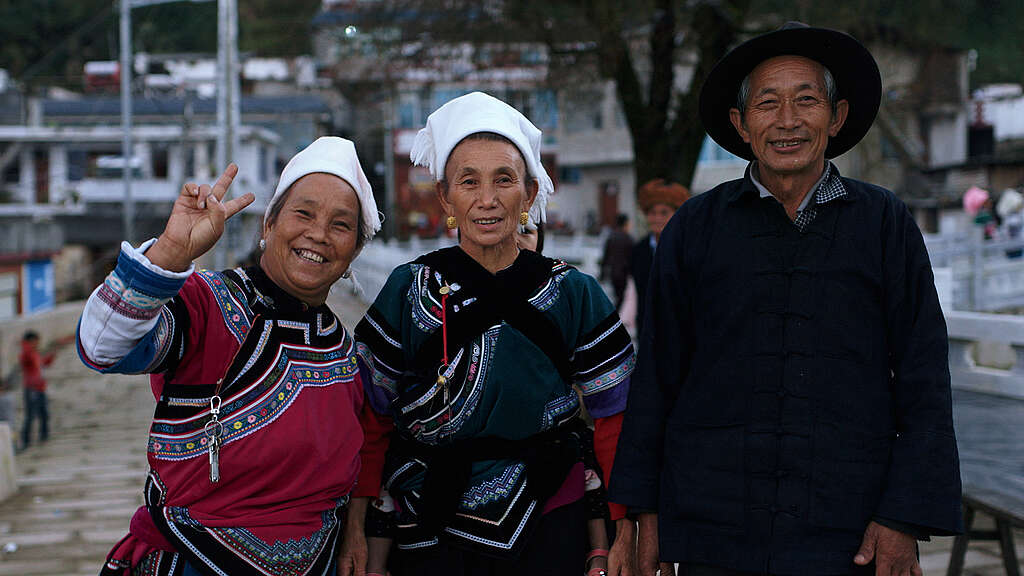
People in town. A still taken from “Unhusk”.
But behind the scenes of this documentary, another unseen factor impacts farming and farmers: climate change.
Since the 1960s, Yunnan Province has seen a significant increase in average temperatures, significant changes in the way rainfall fluctuates from year to year, with an overall downward trend. But more importantly, the precipitation has become more concentrated in certain seasons , with severe droughts in winter and spring. This is the most worrying problem for farmers: lack of water during the critical sowing seasons, even if an excess of late season precipitation comes later.
Changes in precipitation combine with Yunnan’s complex topography to create a water shortage of engineering even during adequate rainfall. People and farms are concentrated in mountain areas, higher up than water basins. For farmers, this means rainfall can’t be stored, flowing away in unusable rivers.
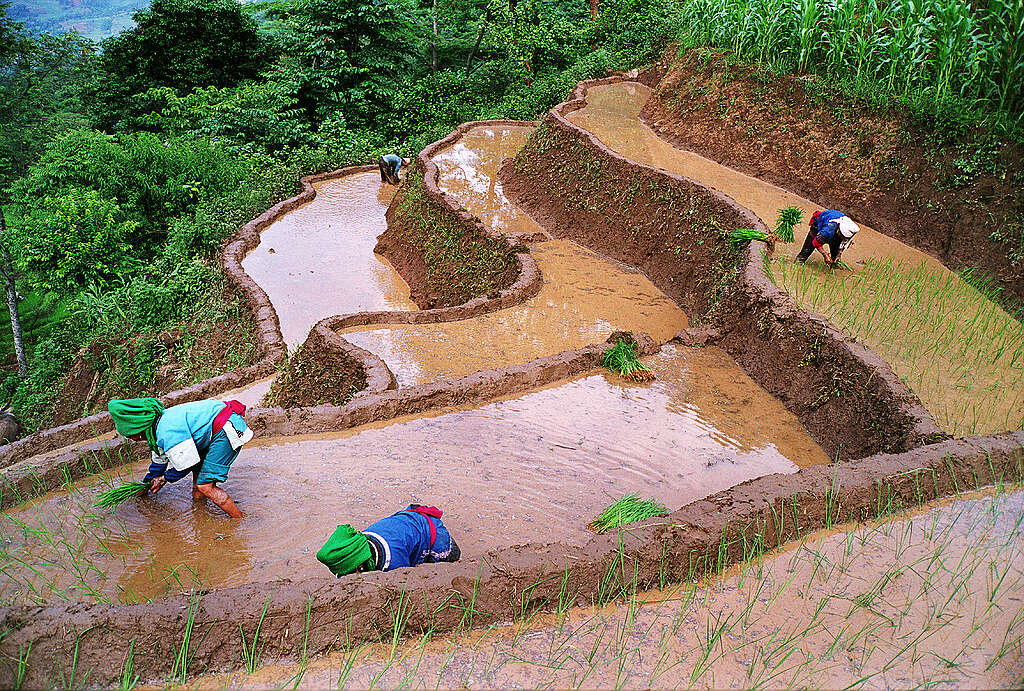
Rice farmers planting in the terraces. © Greenpeace / Li Zikang
The impact of climate change on rice farmers also exists in places not captured by the camera. Wang Jue, the director of the film and Greenpeace’s Public and Cultural Program Specialist, mentioned in a post-screening talk that the village where Ah-Simei lives needs to draw water from the mountains with canals to irrigate rice fields, and the villagers have always negotiated waterproofing for each family.
But because of the spring drought in recent years, when planting time comes, the village’s water supply is always tight. When it’s time for their own families to release water, Ah-Simei and her son have to keep watch over the canals all night to prevent anyone from stealing water. Sometimes conflicts arise when negotiations between neighbors break down.
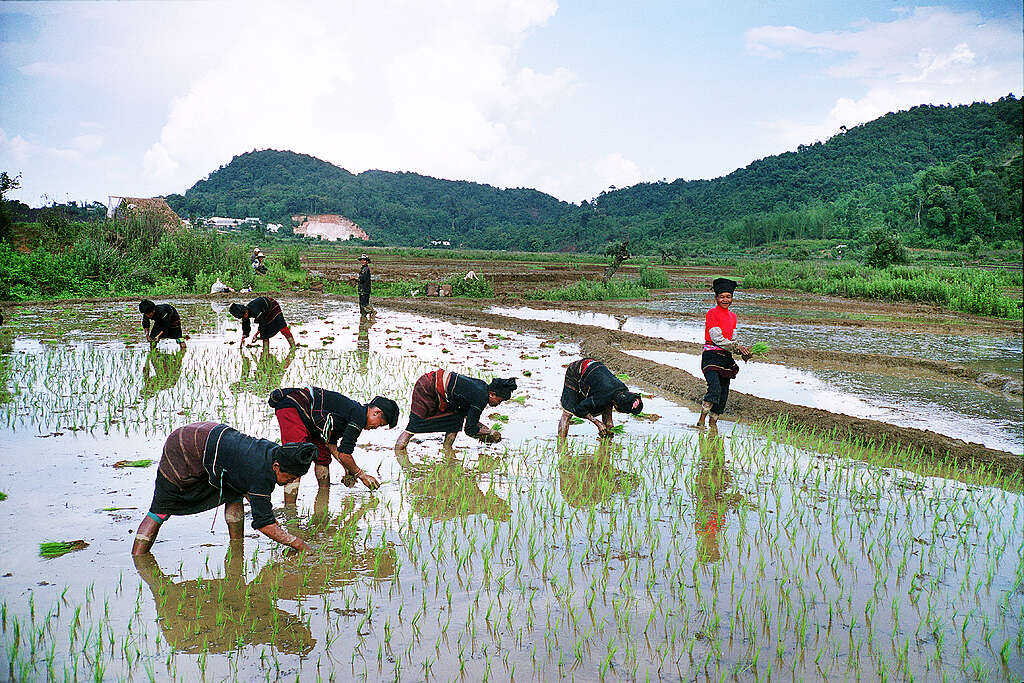
Rice farmers sowing the paddy. Jinghong, Yunnan. © Greenpeace / Li Mingfu
When it comes to the weather, farmers always have a lot to complain about. Farmers in many different places have said that weather-related fluctuations are as unpredictable as market fluctuations, and have become the most critical factor affecting income. In years of climate fluctuations, the price of agricultural products will fluctuate even more dramatically. And even in years of good weather, the problem of low grain prices still occurs. No matter how good or bad it is, the income of the year is unpredictable.
In the past, there were always people who thought that traditional agriculture – “relying on the sky to eat” – is backwards. But the fact is that, whether traditional or modern, the vast majority of farmers believe that “eat by the sky” represents the natural attributes of agriculture. Repairing drains, drilling wells, building greenhouses, and other renovations all have their limitations. There’s no denying the dependence of agriculture on the weather. You can’t fight the weather.
And traditional wisdom has a central role in climate adaptation.
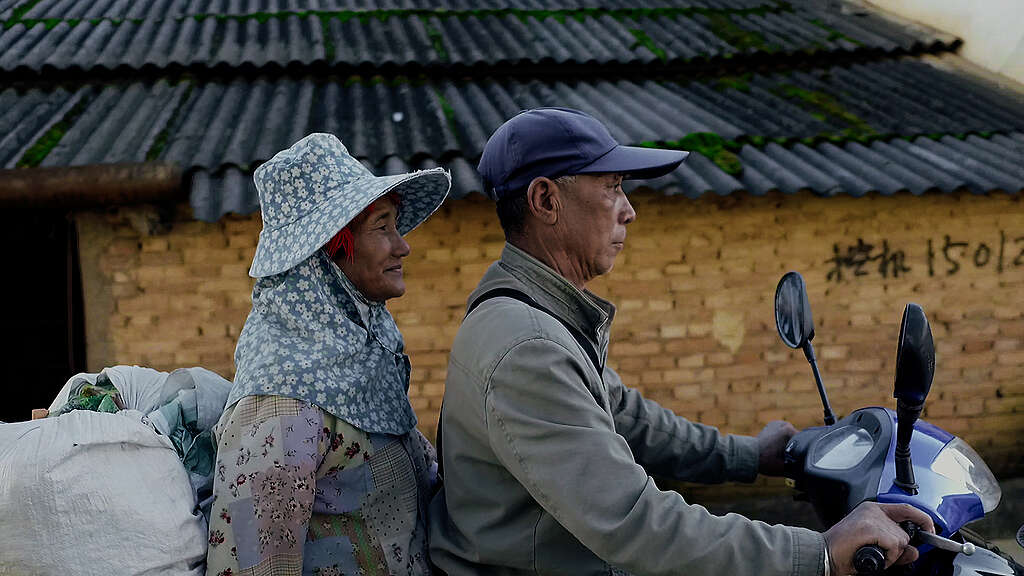
Uncle Lai, driving a scooter with another rice farmer riding behind him. A still taken from “Unhusk”.
In the documentary, most rice farmers no longer keep seeds. Meng Song’s farm seeds have disappeared one after another. Uncle Lai, meanwhile, goes on a search for seed varieties and finds indigenous seeds. Compared to the commercialized hybrid rice variety, Uncle Lai says, this indigenous variety is more resilient, more resistant to insects, and can even produce a harvest without chemical fertilizers.
Like Uncle Lai, many farmers have found that despite lower yields when compared to current commercialized seeds, indigenous seeds are usually more resilient to climate shocks because they are more adapted to face local environmental and climatic conditions. If scientists and farmers work together to apply these local varieties, it will be easier to further develop varieties that are adapted to the shocks of climate change. But in China, local varieties of rice are dwindling, plummeting from more than 46,000 varieties in the 1940s to more than 1,000 in the 1990s.¹ The disappearance of local varieties directly threatens the foundation of the entire breeding system.
For future farmers, the lack of varieties will make it impossible to find seeds with certain characteristics.
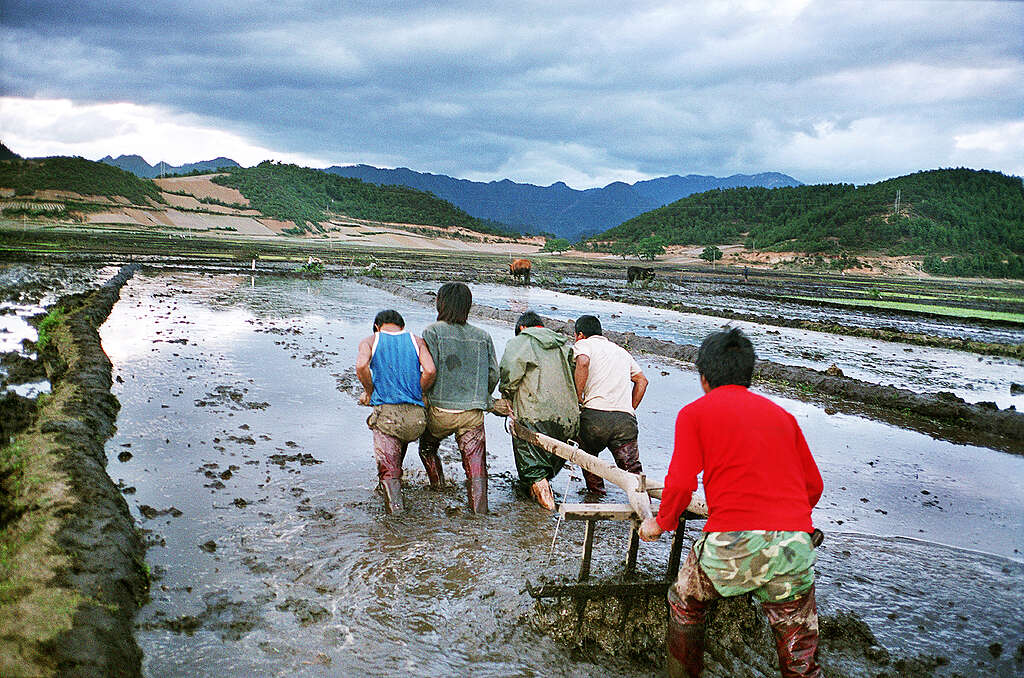
Rice farmers plowing their field in Weixi, Yunnan. © Greenpeace / Xiong Guizhi
In addition to this, mountainous peoples customarily grow rice on terraced fields, with a complex set of water management measures to ensure that water is available for irrigation in times of drought, and that the soil does not erode during heavy rainfall. These are lessons learned by the farmers themselves over the centuries. But as people from the countryside flock to the cities, the labor force in many villages is gradually decreasing, making it more and more difficult to renovate the terraces each year. And even the necessary skills to do so are gradually being lost.
This is another answer to the opening question: when farmers no longer choose to grow rice, it means the end of traditional rice farming.
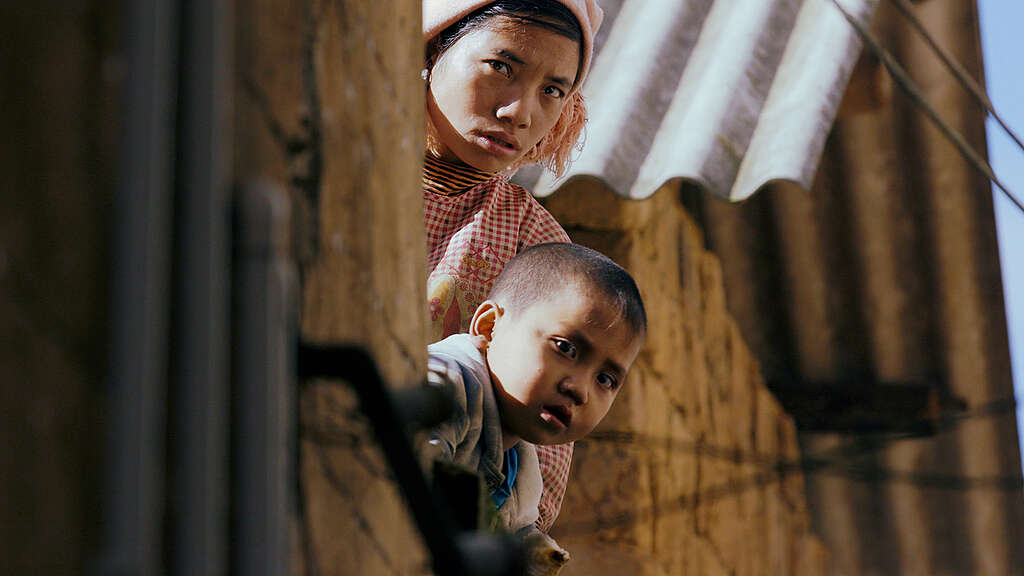
Two children looking over a courtyard wall. A still taken from “Unhusk”.
Tradition does not belong to the past. Climate change’s impact calls us to re-examine traditional rice cultivation methods with a new perspective, and perhaps it can play a bigger role in the future.
Whether they still continue to grow rice or not, the five rice farmers show their deep attachment to rice farming and the life that goes with it. From director Wang’s perspective, they would not want future farmers to rely on pesticides to get rid of pests and weeds, but not understand the ecological relationship between rice and pests and grasses. Or know how to use terraces, but not be able to cultivate them to preserve the soil quality and water supply. After all, some skills cannot be put down in writing and can only be passed on by action. For the sake of our future, let’s not let the wisdom codified in tradition disappear for the next generation of rice farmers.
END
Notes:
